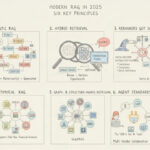The digital landscape is undergoing its most significant transformation since the advent of mobile. We are moving from an ecosystem of search engines to one of answer engines. For enterprises, this shift is fundamental. The game is no longer about ranking in ten blue links; it’s about being the citable, authoritative source within an AI-generated answer.
This new paradigm replaces traditional KPIs. Leadership and traffic are being replaced by visibility, citations, and influence. AI systems are the new primary audience for your content; humans are increasingly the secondary audience, consuming AI-synthesized summaries.
This guide provides the technical and strategic framework to thrive in this new ecosystem. We will cover how to re-architect your website, content, social media, and advertising strategies to be “retrieval-ready.” That is, atomic, citable, and structured to answer questions directly. This is no longer a niche tactic; it is the new foundation for all digital marketing.
Foundations: How AI Ingests Your Digital Footprint
To optimize for AI, you must first understand how it “reads” the web. The process has shifted from simple indexing to active synthesis. This ingestion funnel can be broken down into a clear pipeline.

- Discovery (Crawl): Just like traditional search, AI systems discover your content by following links, processing XML sitemaps, and ingesting structured data feeds (like product feeds). If your content isn’t easily crawlable (e.g., blocked by robots.txt, hidden behind a login), it is invisible to AI.
- Parsing & Chunking: Once crawled, the system parses your HTML to break content into smaller, semantically related pieces called “chunks”. Your HTML structure is critical here: headings (<h1>, <h2>), paragraphs (<p>), list items (<li>), and tables are the primary signals used to define these chunks. A “wall of text” is parsed into a giant, unusable chunk.
- Understanding (Vectorization & Entities): Each chunk is converted into a numerical representation called an “embedding”. This vector captures the semantic meaning, not just keywords. Simultaneously, the AI identifies named entities (your company, products, people) using structured data (like Organization schema) to build a knowledge graph of how everything is related.
- Retrieval (RAG): When a user asks a question, the answer engine uses Retrieval-Augmented Generation (RAG). It searches its index to find the content chunks with the most semantically similar embeddings (the most relevant answers).
- Generation & Citation: Finally, the LLM takes the user’s query and the top-retrieved chunks to generate a new, conversational answer. It then appends citations to the source content it used. Getting cited is the new click-through—it builds credibility and can lead to downstream traffic.
This process highlights a new challenge: the “crocodile effect,” where your impressions may rise (from being cited in AI Overviews) while your clicks decline because the user got their answer without visiting your page. Your goal is to provide the best chunks to be selected for retrieval and cited in the final output.
The Quick Wins Checklist (Immediate Actions)
To make your assets immediately more competitive in this new ecosystem, prioritize these high-impact actions.
- Deploy Organization Schema: Immediately establish your brand as a verifiable entity for AI by adding Organization schema to your homepage. This feeds knowledge panels and disambiguates your brand.
- Audit Robots.txt for AI Crawlers: Add specific directives for new AI crawlers. Decide whether to Disallow data-scraping bots like Google-Extended and GPTBot to protect your IP, while ensuring you Allow indexing bots like Googlebot and PerplexityBot.
- Implement FAQPage & HowTo Schema: Identify your top 10-20 informational pages, blog posts, and service pages. Add FAQPage schema to answer common questions directly and HowTo schema for any step-by-step instructional content.
- Validate & Enrich Product Feeds: Ensure your Google Merchant Center and Meta feeds are complete with gtin, brand, and descriptive title and description fields. This data directly feeds AI shopping results.
- Standardize Heading Structure: Audit your top pages to ensure one (and only one) <h1> tag and a logical, hierarchical structure using <h2> and <h3> tags. This is critical for effective AI content chunking.
- Add Video Transcripts: Make your video content legible and citable by adding accurate, complete transcripts and uploading them (e.g., as .srt files or in VideoObject schema).
- Fix Core Web Vitals (Speed): Address your “red” Core Web Vitals issues. Aim for LCP < 2.5s and CLS < 0.1. AI systems value page experience as a quality signal.
- Add Descriptive Alt Text: Go beyond basic accessibility. Write literal, descriptive alt text for all important images (e.g., “Robotic arm assembling a circuit board”). Multimodal AI uses this to “see” your content.
Core Website Optimization: Building for AI Comprehension
Your website’s technical foundation is the blueprint AI uses to understand your content. Ambiguity is your enemy; clarity is your greatest asset.

Semantic Structure: The Blueprint
AI parsers rely on clean HTML to deconstruct your content. A well-structured page is inherently “retrieval-ready”.
- Headings as an Outline: Every page must have a single, descriptive <h1>. Subsequent <h2> and <h3> tags must create a logical outline. Vague headings like “More Details” are useless; “What are the Key Features of Product X?” is perfect.
- Lists and Tables for “Snippability”: Convert dense paragraphs of features, steps, or data points into bulleted (<ul>) or numbered (<ol>) lists and simple HTML <table> elements. This pre-structured format is easily “snipped” and repurposed by AI into answer boxes and carousels.
The Structured Data Playbook
If HTML is the blueprint, structured data (schema) is the mandatory, universal language for communicating with AI. Use JSON-LD in your <head> to explicitly label your content.
- Organization: Implement this on your homepage. It’s your brand’s digital passport. Critically, include the sameAs property to link to your official social profiles (LinkedIn, Twitter, etc.) and Wikipedia entry. This builds a machine-readable identity graph.
- Product, Offer, & AggregateRating: Essential for all e-commerce pages. Include sku, brand, and a nested Offer object with price, priceCurrency, and availability (InStock, OutOfStock). Also add AggregateRating for review scores.
- Pros & Cons: For product review pages, Google explicitly rewards markup for positiveNotes (Pros) and negativeNotes (Cons). AI loves this format for summarization.
- FAQPage & HowTo: These are high-impact and low-effort. FAQPage markup directly feeds Q&A-style answers. HowTo schema structures your step-by-step guides, making them perfect for voice assistants and procedural queries.
- Article / BlogPosting: Use this for all editorial content. Key properties like author (as a Person schema), publisher, datePublished, and dateModified signal expertise, authority, and timeliness (E-E-A-T) to AI systems.
- VideoObject: When embedding videos, wrap them in VideoObject schema. Include name, description, thumbnailUrl, uploadDate, and, most importantly, the transcript property containing the full text of the video.
Technical Performance amp; Accessibility
The technical health of your site is a direct quality signal.
- Crawlability: Ensure your robots.txt is not blocking critical CSS or JavaScript files that are necessary to render the page.
- Core Web Vitals (CWV): A poor performance score signals a low-quality page, making it less likely AI will prioritize it as an authoritative source. Optimize images, defer non-critical scripts, and use a CDN.
- Accessibility (A11y): An accessible site is inherently more machine-readable. This means using descriptive alt text, proper heading structures, and providing transcripts for all multimedia content.
AI Crawler Governance: Your Digital Doorman
The proliferation of AI has created two distinct classes of crawlers, and managing them via robots.txt is now a critical strategic function for protecting intellectual property.
- Indexing Bots (For Real-Time Answers): These include Googlebot and PerplexityBot. They index your content to provide real-time information for their answer engines. You should ALLOW these to ensure visibility.
- Data Scraping Bots (For Model Training): These include GPTBot (OpenAI), CCBot (Common Crawl), and Google-Extended (Google’s future model training bot). These bots collect public data to train future LLMs. Blocking them is a strategic decision to protect your IP.
Crucially, blocking Google-Extended does not affect your site’s inclusion in Google Search or AI Overviews—that is handled by the main Googlebot.
Recommended robots.txt Directives
Here is a practical, enterprise-grade robots.txt configuration:

Content Strategy for LLMs (Answer Engine Optimization)
AEO is the practice of creating content structured for AI reuse.

Write to be Quoted
Adopt the inverted pyramid model. Your content must provide a direct, concise, and complete answer in the opening paragraph. This “answer-first” text is the perfect candidate for an AI-generated snippet.
Avoid vague pronouns. Each sentence should be self-contained.
- Bad: “This feature helps improve efficiency.”
- Good: “The auto-save feature helps improve user efficiency by preventing data loss.”
Chunk Right
Structure your articles with AI ingestion in mind.
- Use H2s as Questions: Structure articles around the questions users ask (e.g., “How Do Electric Cars Work?”, “What Are the Main Components?”).
- One Idea Per Paragraph: Ensure each paragraph (which becomes a “chunk”) covers a distinct point and makes sense on its own.
- Cite Your Own Sources: To build E-E-A-T (Experience, Expertise, Authoritativeness, Trustworthiness), cite authoritative data within your content. Instead of “Many people prefer X,” write “According to a 2024 survey of 5,000 users, 68% preferred X”. This makes your content a citable source of fact.
Proven Formats for AI
Certain content formats are exceptionally easy for AI to parse:
- Glossaries: A glossary of industry terms is a powerful way to “own” the definition for “What is…” queries.
- Comparisons (X vs Y): These posts directly target high-intent queries. Use tables and bulleted lists to compare features, pros, and cons.
- Checklists & SOPs: AI assistants love checklists for “how to” queries. Use ordered lists (<ol>) to format them clearly.
Optimizing for a RAG-Ready Knowledge Hub
The principles of AEO are not just for public search. They are precisely what’s needed to power your own internal or customer-facing AI chatbots using Retrieval-Augmented Generation (RAG).
Optimizing your public help center for Google is a direct investment in your private AI capabilities. The goal is to create a high-quality, pre-optimized corpus for your AI agents.
- Logical Chunking Strategy: Break long documents into logical, self-contained sections using descriptive headings (<h2>, <h3>). Each section should cover a single sub-topic.
- Metadata is King: Each document in your knowledge base (e.g., Confluence, Zendesk) must have rich metadata. Essential fields include title, dateModified, author, category, and tags. This metadata allows the RAG system to pre-filter its search, dramatically improving relevance and speed.
- Maintain Consistent Schema: Use standardized templates. For example, every “Troubleshooting Guide” should have consistent sections for “Symptoms,” “Cause,” and “Resolution”. This consistency helps the model extract information more reliably.
Optimizing the Extended Footprint (Social, Video amp; Ads)
AI systems ingest data from all public sources, not just websites.
Social Media (LinkedIn amp; TikTok)
- LinkedIn: Your company page is a primary source for B2B entity information. Optimize your “About” section and tagline with keywords that define your expertise. Use LinkedIn Articles for long-form, authoritative content that is indexable by Google and reinforces your E-E-A-T.
- TikTok: This is a major search engine. AI processes keywords from all sources simultaneously: spoken audio, on-screen text, the caption, and hashtags. Ensure your core topic is mentioned clearly in the audio and displayed as text in the first 3 seconds.
Video (YouTube)
YouTube is a massive multimodal answer engine.
- Chapters: Create timestamped chapters (e.g., “0:00 – Intro,” “1:30 – Step 1”). This is a form of structured data for video, breaking it into logical chunks for AI.
- Transcripts: This is the most valuable asset. A full, accurate transcript (uploaded as an .srt file or added to schema) makes 100% of your video’s spoken content indexable and citable.
Advertising amp; Product Feeds
- Product Feed Optimization: For e-commerce, your product feed is your single most important structured data asset. It powers Google Shopping, Meta Ads, and AI-driven retail features.
- title: Must be descriptive and structured: Brand + Product Type + Key Attribute (e.g., “Acme Pro-Lite Runner – Men’s Blue Mesh”).
- description: Must be detailed and feature-rich to match conversational queries.
- gtin: This (e.g., UPC, EAN) is the primary key AI uses to identify your product. Feeds missing GTINs are severely disadvantaged.
- Feed/Schema Parity: The data in your product feed must match the on-page Product schema (especially price and availability). Discrepancies lead to disapproval and erode AI trust.
- GenAI for Creative: Use GenAI to accelerate your creative lifecycle. Rapidly generate and test dozens of ad copy variations and image concepts, allowing you to personalize at scale and quickly find winning messages.
Governance amp; Provenance: The New Compliance
As AI becomes autonomous, you must implement rules to control its behavior and certify your content’s authenticity.

AI Safety Guardrails (For Your RAG Bots)
When deploying your own AI agents, you must implement guardrails to ensure they operate within safe, on-brand boundaries.
- Input/Output Filtering: Block malicious prompts (“prompt injection”) and scan AI-generated responses to block harmful, toxic, or PII-leaking content before the user sees it.
- Topical Guardrails: Instruct your AI to politely refuse to answer questions outside its designated function (e.g., a retail bot refusing to give medical advice).
- Groundedness Detection: Implement checks to ensure the AI’s answer is factually consistent with the source documents it retrieved, which mitigates “hallucinations”.
Content Provenance (C2PA)
In an world saturated with deepfakes, proving your content is authentic is a new strategic challenge. The Coalition for Content Provenance and Authenticity (C2PA) provides an open standard for this.
- The “Nutrition Label” for Content: C2PA allows you to attach a tamper-evident, cryptographically signed “Content Credential” to your images and videos. This manifest lists who created the asset and what tools (including AI) were used.
- Why it Matters: Browsers and social platforms will begin to use these credentials as a signal of trust. Google already requires that AI-generated product images in Merchant Center feeds retain this provenance metadata, or they risk disapproval.
Measuring What Matters: From SEO to AEO
Traditional, traffic-centric metrics are now insufficient. We must adopt a new framework focused on influence and presence.

The Shift: SEO (Traffic-Centric) vs. AEO (Influence-Centric)
- Traditional SEO: Success is measured by rankings, clicks, and on-site conversions.
- Answer Engine Optimization (AEO): Success is measured by influence. The value exchange often happens within the AI interface, before a click occurs. A brand mention in an answer builds awareness and credibility, even without traffic.
New AEO KPIs to Track
- Citation Frequency / Share of AI Voice: For a defined set of strategic queries, what percentage of AI-generated answers mention your brand or content?
- Sentiment Analysis: When your brand is cited, is the context positive, neutral, or negative?
- Rank/Position within Answer: Are you the primary source (position 1) or a secondary citation?
- Attributed Traffic Quality: While clicks may decrease, this traffic is often highly qualified. Monitor the conversion rate of traffic from AI referrals; it is often higher.
RAG System Evaluation (Internal)
For your internal RAG applications, you must use a rigorous, technical framework to measure accuracy.
- Use Evaluation Frameworks: Ad-hoc testing is not enough. Use systematic frameworks like RAGAS or TruLens.
- Track Key Metrics:
- Context Precision/Recall: Did the system retrieve the correct documents from your knowledge base?
- Faithfulness/Groundedness: Does the generated answer stick to the facts in the retrieved documents, or does it “hallinate”?
- Answer Relevance: Does the final answer actually address the user’s original question?
Optimizing for the Age of Synthesis

The shift to an AI-first digital world is not a distant trend; it is the new operational reality. Enterprises that continue to focus purely on traditional link-based SEO will become invisible.
By structuring content for machine ingestion, asserting technical authority, governing AI access, and measuring influence over clicks, you position your brand as the definitive source of truth. The future of digital dominance lies not in being searched, but in being synthesized.





